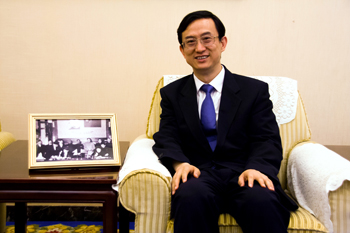China’s ambassador to Nepal, Wu Chuntai, spoke to Nepali Times this week about Nepal-China trade, investment and potential for future cooperation

CINDREY LIU
Wu Chuntain: According to the statistical data from Department of Industry, Nepal has attracted more than $100 million investment from China and Chinese entrepreneurs have established more than 500 local companies in Nepal. In order to boost Chinese investment in Nepal, we suggest that the BIPPA (Bilateral Investment Promotion and Protection Agreement) be signed by the governments of Nepal and China which will significantly enhance our bilateral economic relationship. In addition, the PDA (Project Development Agreement) is vital for Chinese investment in hydropower projects, which is needed for the Chinese investors to finance adequate funding to develop the projects.
What are the main areas of investment that Chinese companies are attracted by in Nepal?
The Chinese companies are engaged in the hydropower sector, tourism, hotel, restaurant industries, etc.
And what would you say are the main obstacles they face for further growth in investment?
The Nepali government has done a lot to attract foreign investors. However, the investors are now facing some common difficulties, such as the political transition, power shortage, lack of raw materials etc. It is believed that more conducive and preferential policies will provide a safe and stable investment environment to attract foreign investors including Chinese investors.
Bilateral trade has also been growing, but it is a bit one-sided. What prospects do you see for balancing Nepal-China trade?
The bilateral trade between China and Nepal has been developing steadily and continuously for many years. The total bilateral trade volume in 2012 reached nearly $2 billion, increasing by 67 per cent, and Chinese imports from Nepal went up by 112.9 per cent, which is the highest rate of increase among South Asian countries. The Chinese government has provided several policies and measures to promote bilateral trade, including duty-free privilege to 95 per cent of total tariff lines as a follow-up to the 60 per cent facility which will be implemented. The Tatopani Dry Port being built under a Chinese grant is under construction and will help Nepal improve its trade facilitation services. All these efforts will draw an optimistic picture of the bilateral trade development between China and Nepal.
Which specific infrastructure and energy projects is China looking at being involved with in Nepal in future?
We are extending the Kathmandu Ring Road and constructing the dry port in
Tatopani, that I mentioned before, with grant assistance. We are also
building the Upper Trisuli-3A hydro power project with concessional loans, preparing the construction of Pokhara International Airport and discussing other potential projects with Nepal government. From the private sector, Chinese investors are looking for different kinds of projects in hydropower and other infrastructure areas. Some are under evaluation process. Sinohydro is constructing the Upper Marsyandi, a joint venture with a local company under build-operate-transfer (BOT) model. The China International Water and Electric Corp (CWE) is also investing in the Upper Modi hydropower project.
How realistic is the trade and transit potential for Nepal to benefit from its location between India and China?
Both India and China are neighbours of Nepal, India is Nepal’s largest trading partner while China is the second largest trading partner. It is through Nepal that some trade activities between China and India happen, like some Indian importers purchase Chinese products through Tatopani in Nepal. It is believed that Nepal has immense opportunities to benefit from its location between the two huge economies. The improvement of
north-to-south transportation infrastructure between Chinese dry ports and Indian dry ports through highways, even railways, through Nepal, will provide great help.
What possibilities are there for tri-lateral cooperation between China, India and Nepal?
Nepal has large potential in hydropower, tourism and infrastructure areas. It offers a good cooperative platform for investors from different countries, including China and India, to boost the Nepali economy. The Chinese government encourages Chinese investors to cooperate with partners from Nepal as well as India. It is also well known by private sector companies that there is a huge potential for benefits from tri-lateral cooperation. We think it is a win-win-win situation.
Read also:
Hands across the Himalaya
“China hopes for social stability"
India or China?